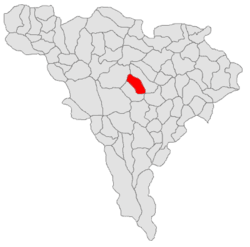Cricău
| Cricău | |
|---|---|
| Commune | |
 | |
 | |
 Cricău | |
| Coordinates: 46°11′N 23°34′E / 46.183°N 23.567°E | |
| Country |
|
| County | Alba County |
| Population (2002)[1] | |
| • Total | 2,097 |
| Time zone | EET (UTC+2) |
| • Summer (DST) | EEST (UTC+3) |
Cricău (Hungarian: Boroskrakkó; German: Krakau) is a commune located in Alba County, Romania. It has a population of 2,097 and is composed of three villages: Craiva (Királypataka), Cricău and Tibru (Tibor).
History
Ancient times
The Dacian fortress on top of Piatra Craivii is believed by many archaeologists to be the location of Apulon. Apulon was an important Dacian political, economic and social center, the capital of the Apuli tribe.
It was first mentioned by the Ancient Greek geographer Ptolemy in his Geographia, under the name Apulon. It is also depicted in the Tabula Peutingeriana as an important city named Apula, at the cross road of two main routes: one coming from Blandiana, the other from Acidava. The two roads merge at Apula, with the next stop on the route being Brucla.
The Latin name of Apulum is derived from Apulon.[2]
Gallery
-

Reformed Church
-

Dacian citadel festival
-

Dacian citadel festival
-

Sânzienele - Dacian citadel festival
-
Wall from Piatra Craivii Dacian Fortress in display at the National Museum of the Union, Alba Iulia
-
Wall from Piatra Craivii Dacian Fortress
-
Import items from the Roman world found at Dacian settlement of Piatra Craivii,
-
Late Bronze Age vessels and bronze objects, from various locations in Alba County, including Piatra Craivii
References
- ↑ (Romanian) "Cricău", at the Erdélyi Magyar Adatbank's Recensământ 2002; Retrieved on September 4, 2009
- ↑ http://www.apulum.ro/en/istoria.htm
Coordinates: 46°11′N 23°34′E / 46.183°N 23.567°E




